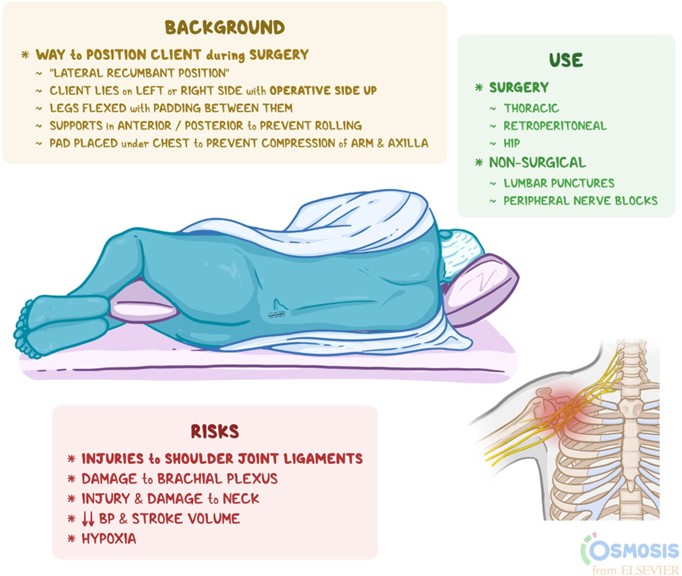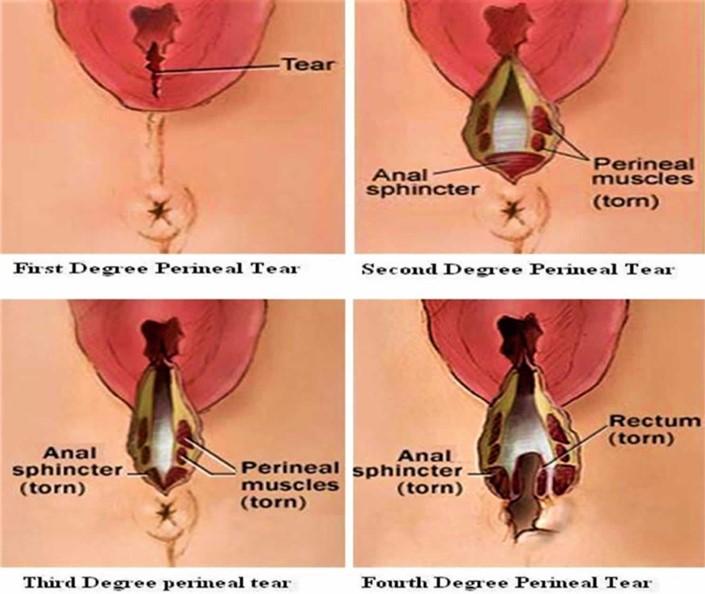A nurse is caring for a client who is receiving oxytocin for the induction of labor and notes late decelerations of the fetal heart rate on the monitor tracing. The nurse should take which of the following actions?
Administer misoprostol 25 mcg vaginally.
Place the client in a lateral position.
Administer oxygen via a face mask at 2 L/min.
Decrease the maintenance IV solution infusion rate.
The Correct Answer is B
Late decelerations are a type of fetal heart rate (FHR) pattern that indicate fetal hypoxia (lack of oxygen) due to uteroplacental insufficiency (decreased blood flow to the placenta). They are defined as a gradual decrease in FHR that occurs after the peak of a uterine contraction and returns to baseline after the end of the contraction¹. Late decelerations are associated with adverse neonatal outcomes, such as low Apgar scores, acidosis, and neonatal intensive care unit admission².
The nurse should take immediate actions to improve fetal oxygenation and blood flow when late decelerations are detected. The first and most important action is to place the client in a lateral position, either left or right, to reduce compression of the inferior vena cava and increase uterine perfusion. This can improve fetal oxygenation and reduce the severity of late decelerations¹³.
The other actions that the nurse should take are:
- Discontinue oxytocin infusion if it is being used for induction or augmentation of labor, as it can cause uterine tachysystole (excessive contractions) and worsen uteroplacental insufficiency¹³.
- Administer oxygen to the client at 8 to 10 L/min via a nonrebreather face mask to increase maternal oxygen saturation and fetal oxygen delivery¹³.
- Increase intravenous (IV) fluid infusion rate to maintain maternal hydration and blood pressure, which can improve uterine blood flow¹³.
- Notify the provider and prepare for possible operative delivery if late decelerations persist or fetal distress occurs¹³.
- Provide emotional support and reassurance to the client and family, as late decelerations can cause anxiety and fear⁴.
The other options are not actions that the nurse should take:
- a) Administer misoprostol 25 mcg vaginally. This is not correct because misoprostol is a medication that is used to induce labor by ripening the cervix and stimulating contractions. It is not indicated for late decelerations and can cause uterine hyperstimulation and fetal distress⁵.
- c) Administer oxygen via a face mask at 2 L/min. This is not correct because this is too low of an oxygen flow rate to improve fetal oxygenation. The recommended oxygen flow rate for late decelerations is 8 to 10 L/min via a nonrebreather face mask¹³.
- d) Decrease the maintenance IV solution infusion rate. This is not correct because this can cause maternal dehydration and hypotension, which can reduce uterine blood flow and worsen fetal hypoxia. The nurse should increase the IV fluid infusion rate to maintain maternal hydration and blood pressure¹³.

Nursing Test Bank
Naxlex Comprehensive Predictor Exams
Related Questions
Correct Answer is D
Explanation
A fourth-degree laceration involves a tear that extends through the perineal muscles and extends to the anal sphincter. This type of laceration requires careful management to promote healing and prevent infection. Applying a moist, warm compress to the perineum helps to promote blood flow, reduce swelling, and provide comfort to the client.
Option a) Providing the client with a cool sitz bath is not appropriate for a fourth-degree laceration. Cool sitz baths are typically used for relieving discomfort and reducing swelling in cases of perineal trauma, but in the case of a fourth-degree laceration, warm compresses are preferred.
Option b) Administering methylergonovine 0.2 mg IM is not necessary for a fourth-degree laceration. Methylergonovine is a medication used to promote uterine contractions and prevent postpartum hemorrhage. However, it is not specifically indicated for the management of perineal lacerations.
Option c) Applying povidone-iodine to the client's perineum after she voids is not recommended for a fourth-degree laceration. Povidone-iodine is an antiseptic solution used to disinfect the skin. However, it is not typically used on open wounds, such as perineal lacerations, as it may delay wound healing.

Correct Answer is A
Explanation
After a client with eclampsia experiences a convulsion, the nurse should immediately prioritize ensuring adequate oxygenation for the client. Administering oxygen via a face mask at 10 L/min helps to increase oxygen levels and support the client's respiratory function. This intervention addresses the immediate need for oxygenation and helps support the client's respiratory function following a convulsion associated with eclampsia. Prompt and appropriate management of eclampsia is crucial to ensure the safety and well-being of both the mother and the fetus.
Option b) Placing the client in a Trendelenburg position (head down and legs elevated) is not appropriate in this situation. It can potentially worsen blood flow to the brain and may lead to increased intracranial pressure.
Option c) Assisting the client to void may be important for monitoring urine output, but it is not the immediate priority following a convulsion. The client's safety and stabilization take precedence.
Option d) Giving calcium gluconate is not indicated for the management of eclampsia. Calcium gluconate is used to treat hypocalcemia or as an antidote for certain medication toxicities. The primary treatment for eclampsia involves controlling and preventing seizures, which is not achieved through calcium gluconate administration.
Whether you are a student looking to ace your exams or a practicing nurse seeking to enhance your expertise , our nursing education contents will empower you with the confidence and competence to make a difference in the lives of patients and become a respected leader in the healthcare field.
Visit Naxlex, invest in your future and unlock endless possibilities with our unparalleled nursing education contents today
Report Wrong Answer on the Current Question
Do you disagree with the answer? If yes, what is your expected answer? Explain.
Kindly be descriptive with the issue you are facing.
